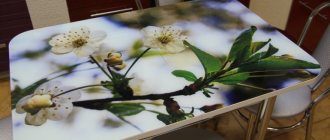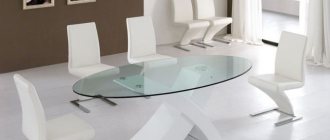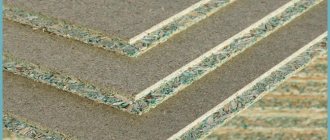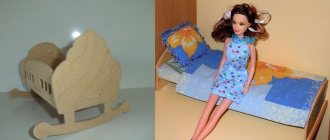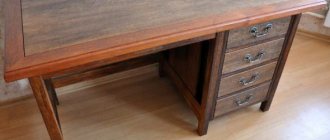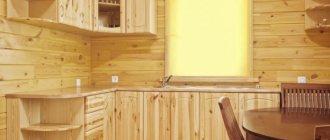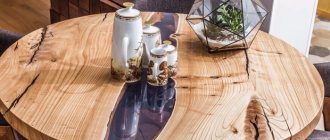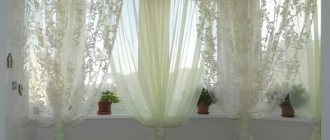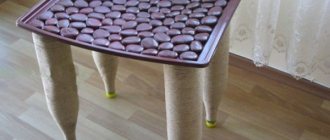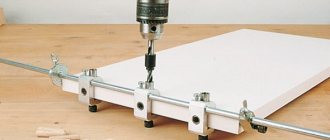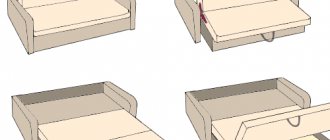table for a sewing machine
Happy owners of sewing machines cannot always enjoy their happiness to the fullest. It gets boring every time you take the typewriter out of the closet and set it on a table - a dining table or a desk, well, if not on a coffee table. But don’t rush to buy a special table; this article clearly shows that it’s a sewing table with your own hands . Limited space or budget or lack of experience will not be a hindrance. Here are the most affordable, low-cost options for tables for a sewing machine , as well as several examples of how to make a cutting table . Having your own sewing corner in an apartment is the dream of every housewife, but in modern small-sized apartments such a dream is unlikely to be realized. This article offers solutions for small spaces and modest budgets. Moreover, the tables were not made by professionals; most of the authors are very far from carpentry. This means that you will also definitely find here exactly your version of a table for sewing equipment .
Design Features
It’s easy to create a full-fledged workplace in a small area. Of course, on an ordinary desk it will not be possible to comfortably arrange fabrics, the necessary tools and a sewing machine. For these purposes, it is better to choose a special transforming table. When assembled, it is a medium-sized bedside table, which, if necessary, folds out into a convenient table for cutting and sewing. Such designs for the home have many advantages: compactness, versatility, ergonomics, plenty of places to store sewing equipment (boxes, shelves, hooks).
How to fold fabrics best
Craft fabrics, like designer paper, felt, foamiran and other materials, take up more space than other accessories. You can store them by folding them several times. However, such storage can damage particularly delicate tissues.
Another quite common technique is in which fabrics and papers are wound on special rods and stored in the form of rolls.
If they are cut into sheets, then it is convenient to organize them into files in folders.
Whichever option is chosen, it is worth remembering that fabrics can fade in the sun and also do not like excessive moisture. For this reason, in your free time, rolls with them need to be covered with film or the boxes with them closed.
Folding sewing table
Even if you don’t often use your sewing machine to sew fabric napkins or hem curtains, it’s still not very convenient when it’s gathering dust on the floor in the closet and periodically you have to take it out and put it on the dining table. Although this is also a solution for a small apartment, it is much more convenient to equip a permanent place, for which it is suitable, which you can do yourself. The author offers this option, as you see in the photo. To do this you will need two 90x50 cm chipboard boards with a thickness of 2.5 cm and three 10x50 cm boards. Four 70 cm high metal pins, an electric drill, screws and spray paint. Cut the boards that make up the top and bottom of the table to the size you need. Use glue and clamps to assemble the table top. Then clean and paint the legs. If you bought new, you probably won't have to clean or paint them. Attach the legs to the tabletop using a drill and screws. Sand and paint the countertop. It took the author several hours, including drying time for the glue and paint. As you can see, everything is very simple.
How to Store Paints, Pencils and Other Art Supplies
For pencils, markers and crayons, you can sew or buy a special organizer. And if you want them to always be in sight, you should make glasses for them from olive cans. They can be easily attached to the perforated panel using wire.
Such improvised cups are perfect for storing brushes, spatulas and other art supplies.
Tubes of paint can be hung using binders or clips. And if the dyes are in bottles, they can be placed on special shelves or placed in plastic containers.
Organizing a needlewoman's workplace in a small apartment or in a large house is always a difficult task, but very interesting. After all, it gives you the opportunity to show your creativity. As you work on this, you can separate your supplies into separate craft kits, which will make your work easier in the future. The most important thing to remember when decorating your corner for needlework: you need to purchase only what is necessary for work. Don’t waste your efforts and money on unnecessary things; prioritize comfort and expediency.
Needlewoman equipment
Although the specializations of craftswomen vary, there is a basic set of equipment, without which needlework for beginners will become not a pleasure, but a real torment, and a very costly one at that.
So, the first tool in the arsenal is a computer. It is with its help that every needlewoman will find information, exchange experiences with colleagues, order the necessary materials, sell her products and develop the design of some of them. In addition, many modern handicraft devices, such as embroidery machines and plotters, require programs that are created on a computer.
In addition, every needlewoman cannot do without a sewing machine, no matter what her hobby is. Handicrafts today are directly related to this device, be it embroidery, knitting or scrapbooking. As for the sewing machine model, if your favorite pastime is not sewing, you can use the simplest machine like your grandmother’s “Podolka” or “Chaika”.
It is advisable that every needlewoman have a printer in her arsenal. Optimally - black and white laser. It will be possible to print details, patterns, layouts and articles from the Internet.
Casket for needlework
No matter how well a craftswoman’s workplace is equipped, there is an item that cannot be avoided. We are talking about a box for needlework. Traditionally, it stores small things for sewing: such as needles, pins, scissors and several skeins of thread.
However, today a crafts box can accommodate significantly more items, becoming a full-fledged repository for all the craftswoman’s tools.
For example, a folding box model is quite popular; it can hold not only needles and scissors, but also the entire palette of threads. Such a device is very practical, especially if the craftswoman goes on vacation for a long time, but does not want to be separated from her favorite hobby.
Cabinet for storing materials
Having figured out the light and location, you need to choose furniture that will serve as a workplace. Whatever the needlewoman specializes in, she will certainly need a cabinet to store materials and equipment. That is why closets with built-in folding tables are becoming increasingly popular among craftswomen. They are ordered according to individual drawings, and sometimes they are made by hand.
How to store buttons, beads and ribbons
As a rule, needlework for beginners is not yet such an important attribute of life, so inexperienced craftswomen have quite a few accessories. However, over time, needlewomen increase not only their skill, but also the number of auxiliary materials such as buttons, ribbons, beads, etc. What is the best way to store them?
There are several possible answers to this question. Some people sort these small items into glass jars, bottles or paper boxes. Another common way to store buttons is in plastic food containers or coffee cans.
Zipper bags or special albums are also used to store buttons and beads.
Ribbons are a little more difficult to fold as they tend to unravel. Some needlewomen secure their ends with pins or tape. However, the most optimal storage option is special boxes with rods on which skeins of ribbons are attached.
Armchair
If you sew, embroider, or spend a lot of time at work, when organizing a needlewoman’s workplace, pay special attention to the chair. If it is equipped with wheels, has adjustable seat height and backrest tilt, you will be less tired while working. Of course, a good chair is expensive, but saved health is even more expensive. An uncomfortable fit leads not only to back pain, but also to spinal deformation.
Tip: You can decorate your office chair with special pockets for small items by attaching them to the armrests. This will immediately give it a cozy, “homey” look.
Where to place your creative corner
Before embarking on such a serious task as organizing a needlewoman’s workplace, it is worth deciding how much time will be devoted to your favorite hobby. If you usually spend no more than an hour a week, or even a month, on needlework, there is no point in spending a lot of time arranging your work corner. It's easier to store tools and craft fabrics in several boxes in a closet, pulling them out as needed.
If you devote almost all your free time to embroidery, scrapbooking, sewing, knitting, painting and the like, it is simply necessary to arrange a corner for yourself to work.
Having started planning the future workplace of a needlewoman, you should immediately decide how much space in the house you can allocate for this. It would be better if there is a separate room for this. Unfortunately, most domestic craftswomen live in apartments, where devoting an entire office to needlework is an unaffordable luxury. The most you can count on is a separate corner or closet. However, if you carefully consider the location of everything, even such a small space will be better used than an entire design studio.
Where to begin? From the choice of location. Since any needlework, in addition to talent and skillful hands, requires acute vision, the needlewoman’s workplace should always be well lit.
The best option is to place it near a window. If this is not possible, you will have to use artificial lighting. Today there are a lot of convenient and bright llamas for needlewomen on sale. As a last resort, you can use LED strip. It is important that the light bulbs do not change the light perception of color, as often happens with such devices.
Tips for choosing
In order to engage in a hobby or work with comfort and pleasure, you need to consider several nuances when choosing furniture:
- In spacious rooms, it is advisable to equip a permanent corner work area near the window. This arrangement has two significant advantages. Firstly, this is natural light, and secondly, the cutting corner table will take up a minimum of space.
- If you use heavy professional equipment in your work, it is recommended to choose a sewing table with reliable metal supports.
- In small apartments, it is advisable to install compact and mobile transforming tables. IKEA offers a wide range of similar furniture, so setting up a work area anywhere is not difficult.
- It is important to consider the size of the sewing machine itself and the mobility of the design.
Patchwork involves constant smoothing of elements. Therefore, be sure to allocate space on the table for safe and comfortable work with a hot iron.
For spacious rooms, a large, massive table with a place for ironing would be an excellent solution.
For small rooms, you should choose the most compact models
A folding table on wheels saves space, and moving furniture will not cause difficulties
